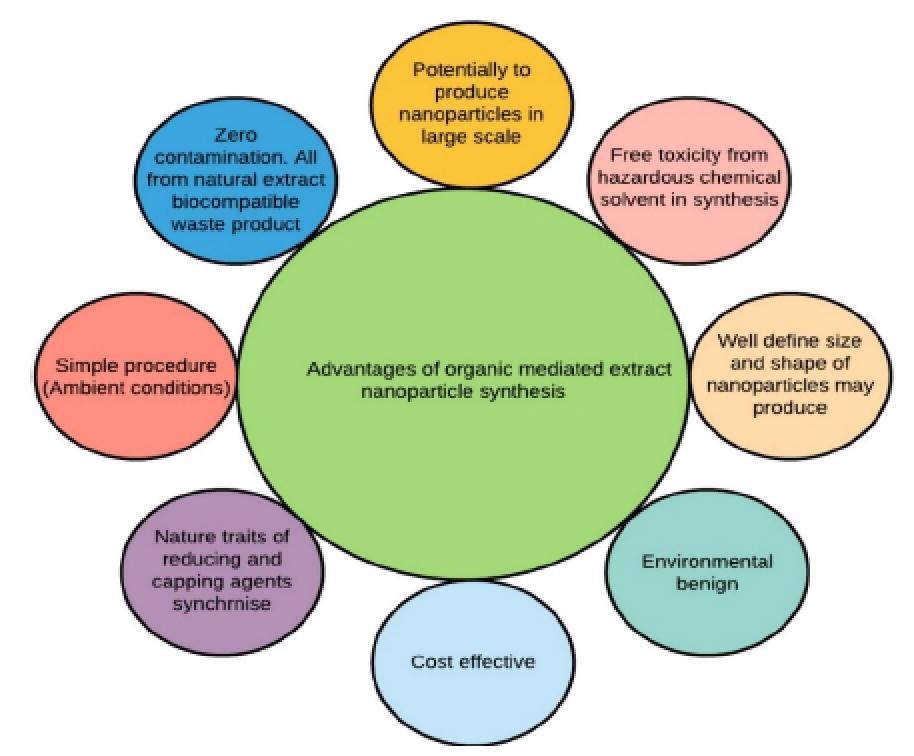A team of researchers recently published a paper in the Journal of King Saud University – Science reviewing the synthesis of nanoparticles (NPs) using different biological agents and their potential applications.

Study: Biological agents for synthesis of nanoparticles and their applications. Image Credit: MW 3DStudio/Shutterstock.com
Background
Green NP synthesis is an innovative field of nanotechnology that outperforms chemical and physical methods of NP synthesis in terms of scalability, eco-friendliness, biocompatibility, and cost-efficiency.
Green synthesis involves the creation of NPs from metal atoms through chemical reduction using green materials.
Green NPs are harmless and used in several biomedical applications as their phytotoxicity and cytotoxicity are substantially lower compared to wet-chemical NPs.
Nonpathogenic biological agents such as algae, fungi, bacteria, and plants are mainly utilized to produce metal oxide and metal NPs through the green synthesis method.
In recent years, metal oxide NPs were used in several applications such as wound healing and immunotherapy due to their exceptional commercial value and applicability.
Synthesis of NPs Using Biological Agents
Virus
Viruses are utilized in the production of artificial nanocrystals such as zinc sulfide (ZnS), cadmium sulfide (CdS), and silicon dioxide (SiO2).
In a virus, the outer capsid protein plays a crucial role in the formation of NPs by generating a highly reactive metallic ion-binding surface.
The size of these synthesized NPs can be reduced by adding a small amount of silver (Ag) and gold (Au) salts in the tobacco-mosaic virus [TMV], along with plant extracts from Nicotiana benthamiana.
Bacteria
Microbes can act as active participants during the production of nanomaterials or biological catalysts during the synthesis of inorganic constituents.
Additionally, bacteria can produce intracellular or extracellular nanomaterials in a broth medium during an incubation phase. Actinomycetes and prokaryotes were used extensively in the production of metal oxide and metal NPs.
Ag NPs are synthesized from Morganella psychrotolerans, Klebsiell`a pneumoniae, Enterobacter cloacae, and Pseudomonas proteolytica, while titanium dioxide (TiO2) NPs are derived from Bacillus subtilis and Lactobacillus sp.
Similarly, Au NPs can be synthesized from Pseudomonas aeruginosa and Rhodopseudomonas capsulate, while Cd NPs can be generated from Clostridium thermoaceticum and Eschecheria Coli.
Fungi
NPs synthesized using fungus are gaining prominence owing to their application in several sectors such as electronics and antimicrobials.
A fungus can generate a significant number of more NPs compared to bacteria.
Additionally, fungi have a considerable advantage over other biological agents owing to the existence of reductive elements, peptides, and enzymes on their cell surfaces.
Different NPs such as zinc oxide (ZnO), Ag, and platinum (Pt) can be synthesized using fungi.
For instance, Ag NPs with 5-15 nm diameters and Pt NPs with 4.5-35 nm diameters can be synthesized from Fusarium oxysporum and Neurospora crassa, respectively. Similarly, ZnO NPs can be synthesized from Fusarium keratoplasticum A1-3.
Algae
Algae can be used to produce metallic nanoparticles.
Proteins present in algal extract serve as a shape-control modifier, stabilizer, and reducer during the synthesis of NPs. For instance, dried algal cells of Chlorella vulgaris can be used to synthesize Au NPs from reduced tetrachloroaurate ions, while Ag/Au bimetallic NPs can be derived from Sargassum wightii, an ocean alga.
Ag and Au NPs can also be synthesized from Spirogyra insignis, Tetraselmisko chinensis, and Kappaphycu salvarezii.
Plants
Plants contain different bioactive compounds such as steroids and alkaloids that act as reducing agents during the synthesis of NPs.
Synthesizing nanoparticles from plant extracts is beneficial as the process is cost-effective and nonpathogenic. Several plants are used in the synthesis of different types of NPs.
For instance, iron oxide NPs are produced from extracts of Camellia sinensis, while ZnO NPs are synthesized from leaf extracts of Coriandrum sativum.
Similarly, titanium oxide and copper oxide can be generated from the extracts of Eclipta prostrata and Aloe barbadensis, respectively.
Potential Applications of NPs
Nanoparticles exhibit complex antibacterial characteristics at low concentrations. For instance, ZnO nanopowders can effectively act against Gram-negative and Gram-positive microbes.
Noble metallic NPs with adjustable and unique optical characteristics, such as Au and Ag NPs, can be used to develop targeted drug delivery methods.
NPs can be effective in targeting cancer cells without causing any significant side effects owing to their huge surface area that allows the combination of high pharmacological doses.
Specifically, ZnO NPs are more suitable compared to other NPs due to their capacity to dissolve in low pH and selectivity.
Anti-infection coating materials become more effective for medical implants when copper oxide (CuO) and ZnO NPs are used in them.
Other applications where NPs can be potentially utilized include vaccines, bioimaging, biosensing, and theranostic applications.

Advantages of biogenic synthesis. © C. Pandit., A. Roy., S. Ghotekar. et al. (2022)
Future Challenges and Perspectives
Innovative green NP synthesis methods will continue to emerge as the sector holds significant potential in a wide range of applications.
However, more studies and data validation is necessary to properly understand the mechanisms responsible for the synthesis of NPs in these methods to achieve the long-term development of green nanotechnology.
Reference
C. Pandit., A. Roy., S. Ghotekar. et al. (2022) Biological agents for the synthesis of nanoparticles and their applications. Journal of King Saud University - Science. Available at: https://www.sciencedirect.com/science/article/pii/S1018364722000507
Disclaimer: The views expressed here are those of the author expressed in their private capacity and do not necessarily represent the views of AZoM.com Limited T/A AZoNetwork the owner and operator of this website. This disclaimer forms part of the Terms and conditions of use of this website.

